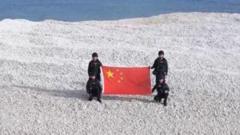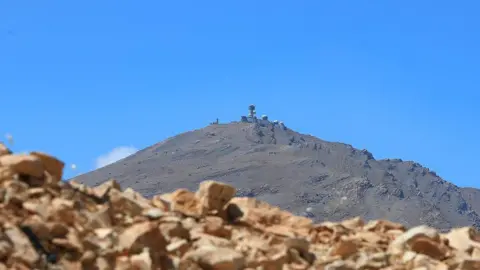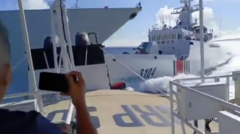The Chinese coastguard has reportedly seized Sandy Cay, a small sandbank in the Spratly Islands, further intensifying regional tensions with the Philippines. State media in China, particularly the CCTV, showcased images of coastguard officers raising the Chinese flag at the disputed site, claiming they have "implemented maritime control and exercised sovereign jurisdiction" over the area since early April.
The Philippines, in response, asserted its claims by staging its own landing on three nearby sandbanks. Philippine officials released images of their officers proudly displaying the national flag, paralleling the Chinese coastguard's actions. The National Task Force West Philippine Sea (NTF-WPS) reported that they observed a Chinese vessel within close proximity to one of the sandbanks and expressed concerns over "the illegal presence" of Chinese militia vessels in the vicinity.
In a statement reflecting the Philippine government's commitment to sovereignty, the NTF-WPS emphasized that they would continue to uphold national rights in the West Philippine Sea. The escalating conflict has given rise to recurring confrontations, including incidents of vessel collisions.
Sandy Cay is strategically located near Thitu Island, a military outpost for the Philippines, which serves as a monitoring point for Chinese activities in the region. Although reports indicate that the Chinese coastguard has left the site for now, the White House has expressed deep concerns over China's seizure assertion, describing it as potentially destabilizing for the region and a violation of international law.
This latest Chinese move comes amid joint military exercises between the United States and the Philippines, known as Balikatan drills, which have drawn critical remarks from Beijing, labeling them as provocative. In the current exercises, involving around 17,000 military personnel, the US has employed advanced missile systems, intended as display of regional defense readiness.
Philippine officials insist the drills are fundamental for national security, with statements underscoring that they are not aimed at any specific nation. Washington’s commitment to bolstering defenses in the Philippines was reiterated during a recent visit by US Defense Secretary Pete Hegseth, reflecting a broader strategy to counter China's extensive territorial claims within the contentious waters of the South China Sea, marked by Beijing's so-called "nine-dash line."
With ongoing disputes over territorial rights dating back centuries, the South China Sea continues to be a focal point of strategic competition among several regional stakeholders including Vietnam, Taiwan, Malaysia, and Brunei, all of whom lay claim to parts of this resource-rich maritime area.
The Philippines, in response, asserted its claims by staging its own landing on three nearby sandbanks. Philippine officials released images of their officers proudly displaying the national flag, paralleling the Chinese coastguard's actions. The National Task Force West Philippine Sea (NTF-WPS) reported that they observed a Chinese vessel within close proximity to one of the sandbanks and expressed concerns over "the illegal presence" of Chinese militia vessels in the vicinity.
In a statement reflecting the Philippine government's commitment to sovereignty, the NTF-WPS emphasized that they would continue to uphold national rights in the West Philippine Sea. The escalating conflict has given rise to recurring confrontations, including incidents of vessel collisions.
Sandy Cay is strategically located near Thitu Island, a military outpost for the Philippines, which serves as a monitoring point for Chinese activities in the region. Although reports indicate that the Chinese coastguard has left the site for now, the White House has expressed deep concerns over China's seizure assertion, describing it as potentially destabilizing for the region and a violation of international law.
This latest Chinese move comes amid joint military exercises between the United States and the Philippines, known as Balikatan drills, which have drawn critical remarks from Beijing, labeling them as provocative. In the current exercises, involving around 17,000 military personnel, the US has employed advanced missile systems, intended as display of regional defense readiness.
Philippine officials insist the drills are fundamental for national security, with statements underscoring that they are not aimed at any specific nation. Washington’s commitment to bolstering defenses in the Philippines was reiterated during a recent visit by US Defense Secretary Pete Hegseth, reflecting a broader strategy to counter China's extensive territorial claims within the contentious waters of the South China Sea, marked by Beijing's so-called "nine-dash line."
With ongoing disputes over territorial rights dating back centuries, the South China Sea continues to be a focal point of strategic competition among several regional stakeholders including Vietnam, Taiwan, Malaysia, and Brunei, all of whom lay claim to parts of this resource-rich maritime area.


















